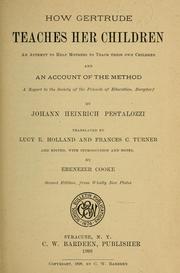Leonard and Getrude and How Gertrude Teaches Her Children
Long before Early Math Counts, the Internet, Head Start, Kindergarten, Maria Montessori and the Industrial Revolution; there was Gertrude.
In 1781, Johann Pestalozzi, Swiss philosopher and educator, wrote the first of four books about the indomitable Gertrude in Leonard and Gertrude. Later, Pestalozzi would write How Gertrude Teaches Her Children. These two books would later became the cornerstone of his theories on teaching and education.
The premise was quite simple. Gertrude was a farm wife and mother who was left to take care of the home and the children while her husband was out (not necessarily working — more likely drinking!). Gertrude kept a warm and inviting home that was filled with the day-to-day activities required to keep a farmhouse filled with children functioning. The local schoolteacher observes Gertrude working with her children, teaching them the essentials of reading, writing, mathematics, and ethics via household tasks and interactions. The schoolteacher then models his school after her example and the local clergyman incorporates Gertrude’s ways into running his parish. Gertrude is credited with saving the town through modeling scrupulous dedication and adherence to a pure moral upbringing of her family.
Clearly the books are a bit more complicated than that, but you get it. The work traditionally done in the home can be the backbone of good education for young children. If you think about it, 100 years ago, young children stayed at home, primarily with their mothers until they were school age. Everything they learned, they learned at home. Mostly children played with each other, observed their mothers taking care of the home, and helped out where expected and possible. Through these interactions, young children were prepared to enter school.
If child care is meant to replicate the home as much as possible then we should include the children in the daily tasks of the classroom. This includes food preparation, set-up, clean-up, laundry, cleaning, and maintenance of the materials. These are genuinely interactive activities that are filled with learning opportunities for cooperation, organization, direction-following, not to mention, an opportunity for children to learn how all of these chores get done.
Sometimes, I think my children believe nighttime fairies come into our home to launder and fold, to clean and organize, to scrub and cook. Gertrude would be appalled.
